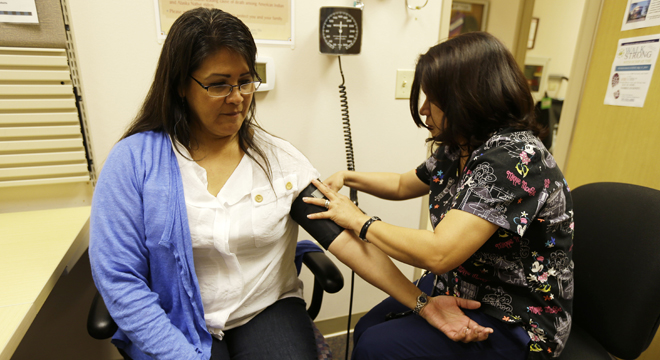WASHINGTON (AP) — The underdog of government health care programs is emerging as the rare early success story of President Barack Obama’s technologically challenged health overhaul.
Often dismissed, Medicaid has signed up 444,000 people in 10 states in the six weeks since open enrollment began, according to Avalere Health, a market analysis firm that compiled data from those states. Twenty-five states are expanding their Medicaid programs, but data for all of them was not available.
Meanwhile, private plans offered through troublesome online markets are expected to have enrolled a much smaller number of people.
The Obama administration plans to release October enrollment statistics this week, but publicly available figures already provide a contrast between a robust start for Medicaid expansion and lukewarm early signups for new, government-subsidized private plans offered separately under the law.
“Medicaid is exceeding expectations in most places,” said Dan Mendelson, Avalere’s president. “It is definitely a bright picture in states that have chosen to expand.”
A big reason for the disparity: In 36 states, the new private plans are being offered through a malfunctioning federal website that continues to confound potential customers. And state-run websites have not been uniformly glitch-free.
Obama’s health care law melded two approaches to advance its goal of broader insurance coverage. Middle-class people with no access to job-based coverage are offered subsidized private plans, while low-income people are steered to an expanded version of Medicaid in states accepting it.
Starting Jan. 1, the law expands Medicaid eligibility to those with incomes up to 138 percent of the federal poverty level — $15,856 for an individual or $32,499 for a family of four. The Supreme Court gave states the right to opt out of the expansion, which is fully financed by Washington for the first three years, gradually phasing down to a 90 percent federal share.
At present, 25 states and the District of Columbia have accepted the Medicaid expansion, which is strongly supported by state hospital associations, medical groups and advocates for the poor. Its main beneficiaries are expected to be low-income adults with no children living at home.
“This is a group of states that’s very committed to aggressive expansion and enrollment,” said Matt Salo, executive director of the nonpartisan National Association of Medicaid Directors.
The White House is promoting the Medicaid expansion. In a visit to Louisiana last week, Obama chided Republican leaders in the states who have turned thumbs down so far. In the audience was GOP Gov. Bobby Jindal, who was not swayed.
If the expansion is seen as a success, that could motivate its supporters in states like Virginia, which just elected Democrat Terry McAuliffe to replace a GOP governor reluctant to widen the scope of government. Another key state is Florida, where GOP Gov. Rick Scott abandoned expansion efforts after hitting stiff opposition in the legislature. An estimated 1.3 million Floridians could potentially qualify.
Avalere’s statistic of at least 444,000 new Medicaid enrollees comes from 10 of the 25 states that accepted the expansion, so it only represents a partial count. Those numbers may also include some individuals eligible for Medicaid under current rules.
In Colorado, Medicaid applications in October were six to nine times what they were the month before, said Sue Birch, who heads the state’s Department of Health Care Policy and Financing.
A yearslong effort to reach eligible residents apparently succeeded in generating the increased demand. The state has installed self-service kiosks in community clinics, hospitals and libraries to sign people up. And a year ago, nurses statewide agreed to help by promoting Medicaid to low-income uninsured patients.
“We said to our nurses: ‘OK, you’re our bounty hunters. You go find our patients,'” Birch said.
Some states have used food stamp rolls to find people who might also be eligible for expanded Medicaid. Income verification forms used for food stamps require frequent recertification, so that means the program’s beneficiaries are Medicaid-ready.
“Medicaid has been around for 40 years,” said Judy Solomon, an expert on the program with the Center on Budget and Policy Priorities, which advocates for low-income people. “In most states there’s a system for determining eligibility that kind of lives with the other public programs. We know already that there are people there who we can ask to raise their hands.”
The nonpartisan Congressional Budget Office has estimated that 9 million people will gain coverage through expanded Medicaid next year, with another 7 million signing up for private coverage through the online markets that are getting off to a slow start.
Medicaid pays doctors less than Medicare, and much less than private insurance, fostering an impression that having a Medicaid card is no better than being uninsured, and maybe even worse. But a recent scientific study debunked that notion, finding that having Medicaid virtually eliminates the risk of catastrophic medical expenses due to a serious accident or the sudden onset of a life-threatening illness. It also found improved mental health, though not much difference in physical conditions such as high blood pressure.
___
Associated Press writer Kristen Wyatt in Denver contributed to this report.
Copyright 2013 The Associated Press. All rights reserved. This material may not be published, broadcast, rewritten or redistributed.






